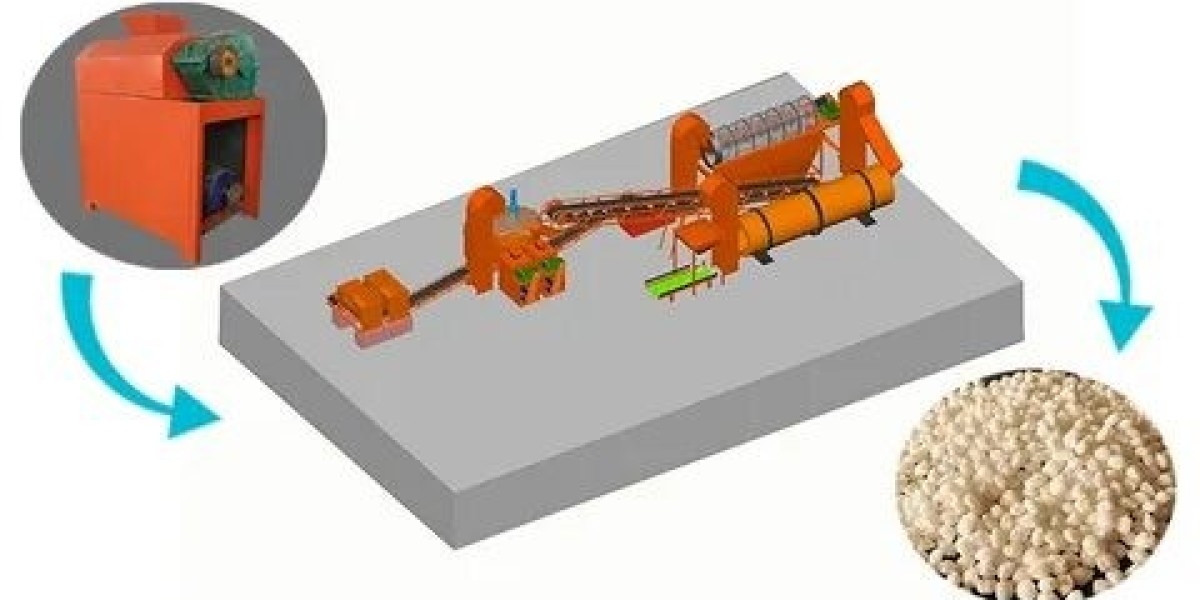The organic-inorganic fertilizer granulation production line represents a cutting-edge solution in the agricultural sector, designed to meet the growing demand for sustainable and efficient fertilizer production. By blending organic materials, such as compost and livestock manure, with synthetic nutrients like urea and phosphates, this production line creates high-quality granules that cater to the nutritional needs of crops while preserving soil health.
Key Features of the Granulation Production Line
Precision Engineering
The granulation production line is equipped with advanced systems that ensure every step of the process is carried out with precision. Components such as dynamic feeding systems, high-speed mixers, and specialized granulators work in tandem to maintain the quality and uniformity of the fertilizer granules.
Automated Operations
Automation is a standout feature of modern granulation production lines. With IoT-enabled systems and programmable logic controllers (PLCs), producers can monitor and adjust parameters such as material ratios, moisture levels, and granule sizes in real-time. This not only improves efficiency but also reduces the risk of human error.
Customizable Outputs
Flexibility in production is crucial, especially for manufacturers serving diverse agricultural markets. The granulation line allows for the creation of custom fertilizer formulations, accommodating varying crop types, soil conditions, and regional climate factors.
Energy Optimization
Designed with energy-efficient components, such as low-resistance dryers and smart heat exchangers, the production line minimizes energy consumption. This is particularly important in today’s climate-conscious world, where reducing carbon footprints is a priority.
Steps in the Granulation Process
Raw Material Preparation
Organic and inorganic inputs are collected, crushed, and screened to remove impurities. The materials are then proportioned accurately based on the desired nutrient composition.
Mixing
A high-performance mixer blends the materials to ensure an even distribution of nutrients. Uniformity at this stage is critical for producing high-quality granules.
Granulation
The mixture is fed into a granulator, where it is shaped into granules of specific sizes. Drum granulators and disc granulators are commonly used, each offering unique advantages in terms of output quality and capacity.
Drying and Cooling
After granulation, the granules are passed through a dryer to remove excess moisture. The fertilizer cooler then rapidly lowers the temperature of the granules, ensuring their structural integrity and improving storage stability.
Sustainability in Focus
The granulation production line emphasizes sustainability at every stage. By utilizing organic waste materials as a core ingredient, it helps reduce the environmental burden associated with agricultural by-products. Additionally, the precision in nutrient blending minimizes nutrient runoff, a major cause of water pollution.
Fertilizer Cooler: Ensuring Quality and Longevity in Production
The fertilizer cooler plays a pivotal role in the fertilizer production process by rapidly reducing the temperature of freshly dried granules. This step is crucial for preserving the physical and chemical properties of the fertilizer, ensuring that it meets the quality standards expected by farmers and distributors.
Key Benefits of the Fertilizer Cooler
Uniform Cooling
The counterflow cooling technology employed in the fertilizer cooler ensures even cooling across all granules. This prevents issues like cracking or deformation, which can compromise the usability and effectiveness of the fertilizer.
Improved Storage Stability
By lowering the granules' temperature, the cooler eliminates residual heat that could lead to moisture absorption or caking during storage. This extends the product's shelf life and maintains its market value.
Enhanced Safety
Hot granules pose a risk of combustion or damage to storage facilities. The cooler eliminates this risk by bringing the temperature to safe levels, ensuring secure handling and transport.
Energy Efficiency
The fertilizer cooler is designed with energy-saving mechanisms, such as optimized air circulation and low-resistance airflow pathways. These features significantly reduce energy consumption while maintaining high cooling efficiency.
How the Fertilizer Cooler Works
Granule Feeding
Hot granules from the dryer are fed into the cooler through an inlet hopper. A regulated feed ensures that the cooling process is consistent and efficient.
Airflow Circulation
Cool air is directed upward through the granules, creating a counterflow effect. This ensures that the granules are cooled evenly, from the inside out.
Temperature Monitoring
Integrated sensors measure the granules' temperature in real-time, allowing for precise adjustments to airflow and cooling duration.
Discharge and Collection
Once cooled, the granules are discharged through an outlet conveyor and transported for further processing or packaging.
Sustainability and Practicality
The fertilizer cooler not only improves production efficiency but also aligns with sustainable practices. By reducing energy consumption and minimizing material wastage, it helps manufacturers achieve eco-friendly production goals. Its compact design and low maintenance requirements make it a practical choice for both large-scale and small-scale fertilizer production operations.
Synergy Between Granulation and Cooling Systems
When integrated, the organic-inorganic fertilizer granulation production line and fertilizer cooler create a seamless production process. The granulation line ensures that the raw materials are transformed into nutrient-rich granules, while the cooler guarantees that these granules maintain their quality during storage and transport. Together, they:
- Enhance production efficiency.
- Reduce operational costs.
- Ensure consistent product quality.
- Support sustainable agricultural practices.
Case Study: Real-World Impact of Modern Fertilizer Equipment
Scenario
A mid-sized fertilizer manufacturer in India faced challenges with inconsistent granule quality and high energy costs. By upgrading to a granulation production line and fertilizer cooler, they achieved remarkable results.
Results
Increased Efficiency: Production capacity increased by 40%, allowing the company to meet growing demand.
Energy Savings: The energy-efficient design of the equipment reduced electricity costs by 25%.
Improved Quality: Granules produced were uniform in size and nutrient content, earning positive feedback from customers.
Sustainability Gains: By utilizing organic waste materials, the company reduced its environmental impact and gained recognition as an eco-friendly manufacturer.
Conclusion
The organic-inorganic fertilizer granulation production line and fertilizer cooler are essential tools for modern agriculture. By combining advanced technology with a focus on sustainability, these systems help producers deliver high-quality fertilizers that meet the needs of farmers while protecting the environment.
Transitioning to such equipment represents a significant step forward for fertilizer manufacturers, offering benefits that extend from the production line to the fields where crops grow. As the global demand for food continues to rise, embracing these innovations will be critical for achieving sustainable agricultural growth.









